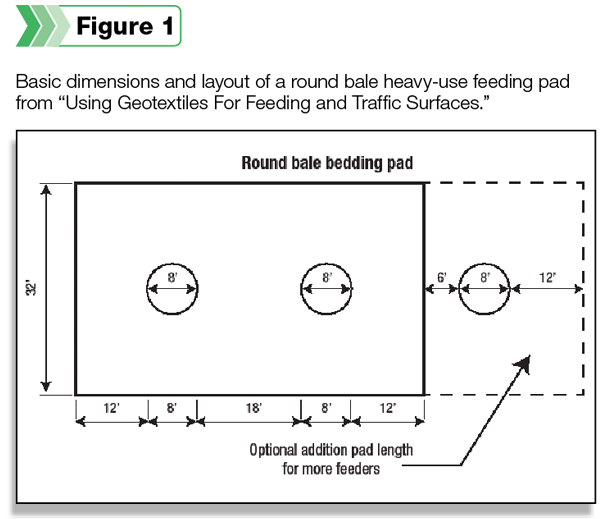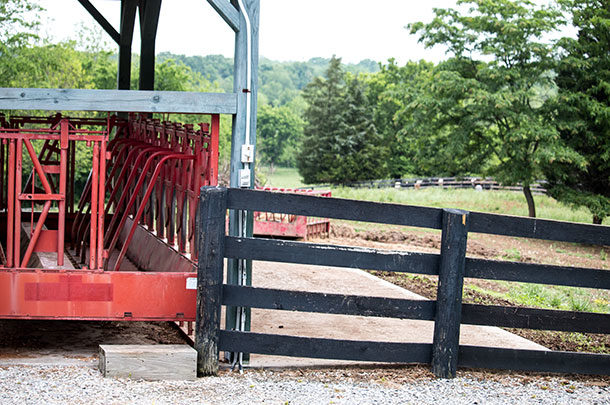But therein lies the conundrum – should we lay hay on the ground or move the feeder around and spread out the damage (and beneficial manure) among several pastures? Or should we confine it to a small area and just know it won’t produce well the following growing season?
While each producer has to answer that question for each operation, the University of Kentucky Master Grazer enewsletter included some points on this topic well worth considering.
Site selection
Site selection of a winter-feeding area is critical in protecting pasture for future grazing periods. By limiting animals to one area, the damage to other pastures is reduced. A winter-feeding site should be well drained. Attention to nearby environmental resources that could be sensitive to runoff should be considered. Examples include area streams, creeks, ponds and floodplains that could become contaminated. By maintaining an adequate distance between a winter-feeding site and sensitive environmental resources, runoff can be filtered by vegetation between the two to prevent contamination. Other considerations for winter-feeding site selection include accessibility, proximate location to feed resources and availability of a reliable, clean water source for livestock.
Feeding considerations
Feed delivery methods require consideration regarding their potential effects on pastures. Concentration of manure and feeding losses are just two areas that can be improved with minimal management. By rotating where animals are fed within a pasture, manure nutrients are more evenly distributed across the area. This can easily be done by moving bale feeders or unrolling bales in different areas on a regular basis.
Animal performance will benefit from reducing mud buildup animals must travel through. Daily intake has been shown to decrease as the mud depth increases. Also, as mud depth increases, energy needs increase and daily gains decrease. Hay feeder type impacts feeding losses. Bale feeders with solid, sheeted bottom portions have been shown to reduce feeding losses and the amount of hay buildup outside of the feeder.
Heavy-use pads
Producers may want to consider the development of a permanent, hard-surfaced winter-feeding area for their operation, rather than feeding livestock in sacrificial fields. Again, a well-drained site a safe distance from any sensitive environmental resources would be the best starting point. A heavy-use pad constructed of geotextile fabric and gravel is one option. These pads are made using geotextile fabric under a 4- to 6-inch base layer of number three or four crushed limestone, topped by 2 to 3 inches of sifted lime known as “dense grade.”
These pads cost approximately one-third as much as a concrete alternative, but require annual maintenance and additional rock over time. Figure 1 shows a basic plan for a heavy-use pad used to feed round bales of hay. In some cases, an access road may be needed to get to a feeding area. By installing an access road into feeding areas, producers can reduce damage to fields caused by tractors or other heavy equipment that create ruts while delivering feed.

For more information on building and developing heavy-use area pads and access roads, click here (PDF, 150KB).
Concrete winter-feeding structures
The construction of a concrete winter-feeding structure can also make winter feeding easier while protecting pastures at the same time. This system brings animals to the hay, as compared with a producer using equipment to take hay to the livestock. This greatly reduces the time, labor and fuel costs associated with winter feeding. Additionally, the design of these structures allows producers to put out multiple days worth of feed, again reducing the amount of time dedicated to winter feeding.
The location of a winter-feeding structure can be installed for use with multiple pastures, reducing the amount of land damaged by densely stocked winter feeding. Producers can switch to different pastures during winter to allow cattle to distribute manure more evenly. Manure management within a structure is easier because of the hard surface to collect manure on, which can then be used to fertilize pastures and hayfields. A rock and geotextile pad can be used for access to the concrete winter-feeding structure to minimize mud.
For more information on constructing a winter-feeding structure, refer to the following University of Kentucky publication: “Strategic Winter Feeding of Cattle using a Rotational Grazing Structure” (PDF, 838KB).
No matter how producers choose to deliver winter feed, consideration should be given to how they can most effectively reduce damaging pastures while conserving time and feed resources. FG
—Excerpts from University of Kentucky Master Grazer enewsletter, September 2015
PHOTO: Sherwood Acres in Kentucky uses a dedicated pasture for winter feeding and has developed concrete feeding pads to minimize hoof damage and collect manure to use on pastures. Photo by Lynn Jaynes.








